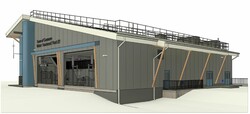
What is Happening
We are replacing our 40-year old Pumphouse with a new Water Treatment Plant and will be decommissioning the current facility.
The new facility will be located next to the existing plant at 300 Spray Lakes Road and will provide a substantial increase in treatment capacity to accommodate our growing community.
What You Need to Know
Construction kicks off in March, and we aim to complete the project in 2025.
Expect increased traffic and machinery around the construction site. Please respect signage and safety guidance in the vicinity of the construction site.
Learn More
If you have questions, contact publicworks@canmore.ca
